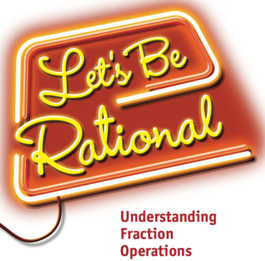Let's Be Rational: Understanding Fraction Operations
Topics
Addition, subtraction, multiplication and division of fractions, and fact families.
Overview of Changes
Minor Changes: More work with fact families with a focus on algebra and choosing and applying appropriate operations in problem solving in Investigation 4.
Detailed Description of Changes
Let’s Be Rational (formerly called Bits and Pieces II) has undergone less substantial changes in response to the Common Core State Standards (CCSS) than Bits and Pieces I has. CCSS requires addition and subtraction of fractions with like and unlike denominators at fifth grade. As a result, these topics are revisited in a single investigation in this unit with a focus on conceptual understanding of why the algorithms work. The same emphasis is applied to the conceptual development of multiplication and division of fractions. Preparation for algebra work to come are other important changes in Let’s Be Rational.
Addition and Subtraction
The first two investigations of CMP2's Bits and Pieces II have been collapsed into a single investigation so students and teachers can revisit and build upon addition and subtraction concepts relatively quickly, including estimation. The original sequence of problems leading to addition and subtraction algorithms remains intact so that when a classroom of students needs to spend more time on the topic, they will have the necessary resources to do so.
Multiplication
In response to teacher feedback, the first problem of the multiplication investigation lingers on the idea of finding parts of parts, rather than rushing to using multiplication to express these relationships. Additionally, the distributive property—first introduced and named in Prime Time in CMP3—is revisited here and used to develop algorithms for multiplication of fractions and mixed numbers.
Division
CMP3 is the first major revision of the division of fractions investigation that was introduced in a copyright update in CMP1. Teachers did not have enough experience with that investigation to give the kind of rich feedback needed for a substantial revision. The current version is based on the following concerns about the original investigation:
- The early emphasis on division of a whole number by a unit fraction (i.e. those of the form 1/n) can cause some students to focus on patterning work (multiply by the denominator), rather than on thinking about the relationships among the numbers involved, and
- Switching back and forth between the measuring (how many groups) and sharing (how many in each group) interpretations makes it challenging to build a robust meaning for division of fractions.
In response to these concerns, a new problem is introduced at the beginning of the investigation. This problem emphasizes estimation and the measuring interpretation of division. Students are asked to consider how much of this is in that? in context using fractional dividends and divisors.
The first two problems in the investigation involve the measuring interpretation of division, and the third involves the sharing interpretation.
Algebra
The fourth investigation is new. In response to the increased emphasis on algebra and properties of operations at sixth grade in CCSS, this investigation uses fact families to investigate these properties in the abstract. The first two problems are designed to suggest ideas of inverse and of decomposition that will be useful in writing, reading and working with algebraic equations later in the curriculum.
The unit finishes with a problem type common in CMP3—a set of contextual problems in which students need to determine which operations make sense.
| New Investigation | Changes in CMP2 Investigations |
|---|---|
| Investigation 1 Extending Addition and Subtraction of Fractions | Investigations 1 and 2 have been combined |
| Investigation 2 Building on Multiplication of Fractions | Investigation 3 is essentially the same with some editing of problems. There are now 3 problems |
| Investigation 3 Dividing with Fractions | Investigation 4 is similar except division of improper fractions are done first. |
| Investigation 4 Wrapping Up the Operations | New Investigation 4. Fact Families with a focus on algebra is included. In the final problem students are given several problems and must decide which operation to use. |
